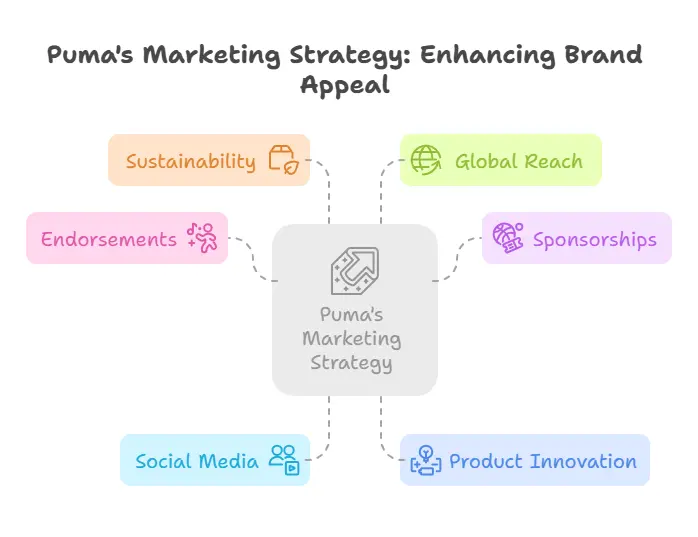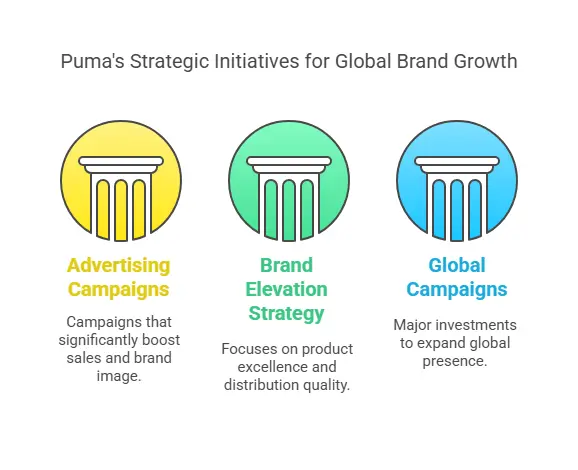Table of Contents
Puma, the international sportswear giant, has solidified its dominant market position with an innovative marketing campaign. With over €8.6 billion in revenues in 2023, the brand continues to fight industry giants Nike and Adidas. Puma, established in 1948, has become a brand associated with fashionable, high-tech sportswear, fueled by strategic branding, endorsement contracts, and online campaigns. In this article we are discusing about puma’s marketing strategy.
One of the major support pillars of Puma’s marketing strategy is its emphasis on sports sponsorship and celebrity endorsement. Through identification with leading sportsmen, fashion icons, and pop culture icons, Puma boosts its popularity. Its digital communication, social media presence, and green efforts further expand its global reach.
Unlock the Power of Digital Marketing! Join Our Free Trial Course Today
Overview of Puma’s Brand Positioning
Puma has established itself as a performance, lifestyle, and sustainable sports fashion brand globally by striking a balance between these dimensions. As an early mover high-performance sports equipment player, the company has transformed to fashionable sports fashion to reach both users and mass consumers. Sponsorship of sports legends such as Usain Bolt and Neymar Jr. ensures its leadership in the performance category, while endorsement with celebrity fashion icons such as Rihanna and Selena Gomez is establishing its lifestyle credentials. Virat Kohli became the main Puma brand ambassador in 2017 when he signed a record-breaking ₹110 crore deal. His brand endorsement provides Puma with a higher bargaining power in India because it emphasizes performance and long-standingness. Puma and Kohli combine sport and life fashion under the One8 brand that enhances Puma’s competitive position in sports as well as in casual wear.
Sustainability is also among the key pillars of Puma brand strategy. Initiatives such as biodegradable shoes and recycling reflect its focus on cleaner innovation, improving its competitive edge in the changing sportswear market.
Puma’s Target Audience
1: What is the primary goal of SEO (Search Engine Optimization)?
Puma is aiming for sport athletes, millennials, and Gen Z customers interested in performance, fashion, and sustainability. It engages sport athletes with the highest performing equipment and engages the younger generations with fashion collections and social culture.
Puma formulates its marketing strategies to most appropriately target its multicultural audience—athletes, millennials, and Gen Z—by focusing on each individual’s taste and values.
When it comes to sports players, the emphasis of Puma is on the innovation and performance of its products. With endorsements by sports personalities of global fame like Virat Kohli, Usain Bolt, and Neymar Jr., the company continuously reminds consumers of the emphasis on high-performance sportswear.
To reach millennials and Gen Z, Puma employs online media, social media, and influencer partnerships. Utilizing collaborations with fashion icons such as Rihanna allows Puma to reach these younger generations in style, with comfortable athleisurewear. Aggressive ad campaigns and content highlighting the overlap of sport, fashion, and culture are strongest in reaching this audience.
Secondly, Puma’s emphasis on sustainability resonates with green-conscious consumers, especially the younger demographic, who place importance on environmentally friendly and socially responsible practices. By utilizing recycled materials and placing emphasis on its sustainability efforts, Puma is a brand that not only delivers performance but also social responsibility.
Become an AI-powered Digital Marketing Expert
Master AI-Driven Digital Marketing: Learn Core Skills and Tools to Lead the Industry!
Explore CourseKey Elements of Puma’s Marketing Strategy
Puma’s brand strategy is based on a number of basic elements that render the brand competitive in the international sportswear industry. These elements are performance, lifestyle, innovation, and sustainability, which establish Puma as the preferred sportswear brand among fashion-conscious consumers as well as athletes.
- Sportsperson and Celebrity Endorsements: Puma collaborates with leading sportspersons such as Usain Bolt and Virat Kohli, as well as celebrities such as Rihanna, to boost brand credibility and appeal. Through such endorsements, Puma is able to retain close ties with both performance-oriented and lifestyle-oriented consumer segments.
- Sponsorships and Partnerships: The company sponsors different sports teams, events, and sportsmen participating in different sports such as football, running, and motorsports. This puts Puma in the limelight in the performance segment and increases visibility among sports enthusiasts.
- Social Media and Influencer Marketing: Puma invites the millennials and Gen Z to interact via social media, influencer partnerships, and engaging digital marketing campaigns. They leverage Instagram, TikTok, and YouTube to produce real, natural content.
- Product Innovation and Design: Puma invests in the development of high-performance, fashion-forward products that appeal to athletes and non-athletes. Fashion collaborations with the likes of Rihanna and Pharrell Williams produce fashionable, limited-edition collections appealing to fashion-forward youth.
- Sustainability and Green Practices: Puma utilizes eco-friendly materials, including recycled materials, in its products. Its focus on sustainability not only attracts green customers but also enhances its image as a responsible business.
- Global Reach and Local Relevance: Although it is a global brand, Puma also adapts its marketing strategy according to local markets. For instance, the Puma strategy in India uses the popularity of cricket player Virat Kohli to win over local sporting culture.
Digital Marketing and Social Media Campaigns
To engage younger buyers, Puma’s social media and digital marketing are focused on Instagram, Tiktok, and YouTube. The brand is reached by consumers naturally and in a manner that they can relate to through viral challenges, influencer collaborations, and interactive content.
Through celebrity and sport star collaborations such as Rihanna, Dua Lipa, and Neymar Jr., Puma extends itself in both fashion and sport. To engage the audience further the company also employs short films and hashtag challenges.
Within a competitive market place of Nike and Adidas, Puma’s digital marketing strategy interweaves sports, lifestyle, and entertainment to stay relevant.
Puma’s viral ads and user-generated content (UGC) aim at interacting with the audience by sharing fun challenges and hashtags. #PumaFit and #RunTheStreets campaigns encourage users to share their fitness success, fashion style, and sporting experience, thereby promoting a great sense of belonging. Through UGC, Puma promotes brand awareness and gets attention from the audience, thereby making its ad campaigns more genuine and interactive. These attempts enhance Puma’s visibility and have more brand touchpoints, particularly among millennials and Gen Z.
Launch your career in digital marketing with our comprehensive course. Enroll now!
Influencer and Celebrity Partnerships
Improving Puma’s profile and trustworthiness in global marketplaces is a key objective of the company’s influencer marketing campaign. The collaborations between Puma and well-known musicians, sportsmen, and influencers allow the brand to reach a wide audience by fusing sports performance with fashion and pop culture. The collaborations help Puma maintain its reputation as an innovative and forward-thinking brand that appeals to customers with a passion for sports and active living.
Usain Bolt: Represents Puma’s commitment to speed and agility.
Rihanna: Catches the eye of millennials and Gen Z with her fearless and trend-right take on Puma apparel.
Selena Gomez: Positions Puma as a cutting-edge athletic brand that caters to trend-conscious youth.
This further establishes Puma as the go-to brand for athletic performance and casual attire.
Sports Sponsorships and Events
In order to further establish itself as a high-performance brand, Puma’s sports marketing approach is centered around sponsoring prominent teams, athletes, and events in a variety of sports. These sponsorships allow Puma to stay prominent in the sporting communities around the world and stay true to its principles of innovation, speed, and endurance.
When it comes to football, Puma is a major sponsor of both professional and national teams. This includes AC Milan, Borussia Dortmund, Manchester City, and Italy. In order to solidify its position in the most watched sport in the world, the company also has the support of famous players such as Antoine Griezmann and Neymar Jr.
Motorsports: Puma supplies high-performance gear and apparel to Formula 1 teams like Mercedes-AMG Petronas and Scuderia Ferrari, furthering the brand’s association with speed and innovative technology.
When it comes to track and field, Puma is synonymous with record-breaking Usain Bolt, one of the elite athletes that Puma sponsors.
In addition to its sponsorship of cricket players like Virat Kohli, Puma has re-entered the basketball market with the support of upcoming NBA stars, broadening its appeal to a variety of athletic communities.
Boosting brand recognition and reinforcing Puma’s dedication to performance, innovation, and global sports culture, these Puma sports marketing initiatives are surefire winners.
Sustainability and Ethical Marketing
Puma incorporates sustainability into brand promotion through its pursuit of initiatives like “Forever Better,” which helps reduce environmental impact and offer ethical means of conducting business. As one of its Puma branding sustainability, the company integrates organic content, ethical procurement, and eco-friendly manufacturing procedures into the product.
- Green Product Lines: Puma product lines incorporate recycled materials, like the Puma x First Mile line, which turns plastic waste into performance wear.
- Reduced Carbon Footprint: Puma has invested in reducing CO₂ emissions along its supply chain and in renewable energy.
- Fair Labor Practices and Ethical Sourcing: Puma employs fair labor and ethical raw material sourcing, a reflection of a broader commitment to corporate citizenship.
Through adopting sustainability in marketing, Puma addresses the environmentally conscious consumers particularly Gen Z, who look for ethical and sustainable brands. All of these make Puma a socially responsible sportswear industry leader.
Puma’s Advertising Campaigns
In order to create a broad base, Puma Ad campaigns are based on a mix of sport, lifestyle, and empowerment. “Forever Faster” is about sports greatness and velocity through the likes of Usain Bolt and Neymar Jr., while “She Moves Us” is based on the liberation of women. Emotional storytelling and rapid cuts are the cornerstones of Puma Ad campaigns.
Puma Ad campaigns penetrate global markets through social media, online advertisements, and influencer partnerships. The company establishes a competitive advantage over other competitors such as Nike and Adidas through the combination of sport performance and fashion, thereby constructing its brand in both disciplines.
Through Puma’s advertising campaigns, the company establishes an emotional bond with its customers through a mix of sport, fashion, and motivation to remain in vogue with the competitive market of sportswear.
Puma’s Competitive Edge in the Market
Puma distinguishes itself from Nike and Adidas by virtue of its ability to harmonically blend performance, price, and fashion-relevance, therefore creating a competitive edge. Puma mixes sports technological innovation with fashion-forward urban lifestyle design appealing to the athlete as much as the fashion-conscious wearer. Nike is high-end athletic apparel-specialized while Adidas specializes in technology and urban streetwear cooperation.
Puma’s success can be mostly attributed to its relative lower cost than Nike and Adidas. Puma provides premium sportswear at reasonable rates that would enable everyone to afford. To set itself apart from performance-driven rivals, the brand also sponsors well-known personalities like Rihanna, Selena Gomez, and Dua Lipa, so strengthening its streetwear and lifestyle profile.
Apart from that, Puma leads innovations particularly in running, football, motorsport, and athletics. Support of sports stars like Neymar Jr. and Usain Bolt as well as Formula One teams like Ferrari and Mercedes-AMG helps Puma to keep hold on professional sports. Puma leads the sportswear market by means of the combination of sustainable practices, fashion designs, and reasonably priced sportswear.
By merging sport, fashion, and affordability, Puma maintains a strong global presence, appealing to both professional athletes and everyday consumers alike.
Become an AI-powered Digital Marketing Expert
Master AI-Driven Digital Marketing: Learn Core Skills and Tools to Lead the Industry!
Explore CourseResults and Impact of Puma’s Marketing Strategy
- Puma’s advertising campaigns have been a major contributor to its financial performance and brand image. In 2024, it recorded a 4.4% rise in currency-adjusted sales, an indication of the success of its advertising campaigns in generating revenues.
- The execution of Puma’s Brand Elevation Strategy has mirrored significant brand perceptions improvement among the customers. It is product excellence uplift and distribution quality improvement focused, further leading to enhanced market presence.
- In order to further consolidate its market position, Puma launched its first global campaign in a decade, coupled with a 40% increase in marketing spend. This major investment is a testament to Puma’s efforts to establish its brand identity and expand its global presence.
Launch your career in digital marketing with our comprehensive course. Enroll now!
Conclusion
Puma’s marketing approach is a great balance of sports performance, lifestyle interest, and online interaction to generate its income, market share, and brand reputation. Puma stays current and competitive with Nike and Adidas depending on celebrity endorsement, social media marketing, sponsorship of sports, and green campaign. Other companies might learn from Puma’s ability to appeal to many consumers by balancing newness, pricing, and cultural relevance. Puma’s approach shows how effective real storytelling and collaborative work are in obtaining brand success. Which is your favorite Puma campaign? Let us know in the comments!
Frequently Asked Questions
How does Puma position itself in the market?
Puma balances affordable sportswear with fashion-forward designs, appealing to both athletes and casual consumers.
How has Puma’s marketing strategy impacted its growth?
Puma’s marketing has driven increased sales, global brand recognition, and stronger consumer engagement, making it a major player in the sportswear industry.
What can other brands learn from Puma’s strategy?
Brands can learn to combine sports, fashion, and digital marketing while staying innovative and eco-conscious to connect with modern consumers.
Who is Puma’s target audience?
Puma primarily targets athletes, millennials, and Gen Z, focusing on those who value style, performance, and sustainability.
Which celebrities and athletes endorse Puma?
Puma collaborates with Usain Bolt, Neymar Jr., Rihanna, Selena Gomez, Dua Lipa, and Virat Kohli, among others.
What sports does Puma sponsor?
Puma sponsors football (Manchester City, AC Milan), motorsports (Ferrari, Mercedes-AMG), athletics (Usain Bolt), basketball, and cricket (Virat Kohli).
What lessons can startups learn from Puma’s marketing?
Startups can learn to embrace digital marketing, influencer collaborations, sustainability, and emotional storytelling to build a strong brand identity.













